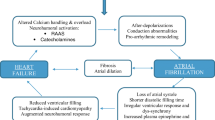Abstract
Atrial fibrillation (AF) is the most common sustained cardiac arrhythmia encountered in clinical cardiology, particularly in patients with heart failure. Its prevalence increases with the degree of left ventricular dysfunction and severity of heart failure symptoms. The development of AF in the setting of heart failure has been shown to result in increased mortality. Studies thus far indicate that rhythm control with antiarrhythmic drug therapy or catheter ablation offers both symptomatic and probably survival advantage in patients with heart failure and AF. In patients with permanent AF, the effects of restoring a regular ventricular response with atrioventricular junction ablation followed by biventricular pacing remain to be shown. In the current manuscript, we will review the proposed mechanisms of increased morbidity and mortality associated with AF and the current treatment options including the roles of radiofrequency ablation and pacing.
Similar content being viewed by others
References and Recommended Reading
Go AS, Hylek EM, Phillips KA, et al.: Prevalence of diagnosed atrial fibrillation in adults: national implications for rhythm management and stroke prevention: the AnTicoagulation and Risk Factors in Atrial Fibrillation (ATRIA) Study. JAMA 2001, 285:2370–2375.
Wang TJ, Larson MG, Levy D, et al.: Temporal relationship of atrial fibrillation and congestive heart failure and their joint influence on mortality: the Framingham Heart Study. Circulation 2003, 107:2920–2925.
Middlekauff HR, Stevenson WG, Stevenson LW: Prognostic significance of atrial fibrillation in advanced heart failure: a study of 390 patients. Circulation 1991, 84:40–48.
Dries DL, Exner DV, Gersh BJ, et al.: Atrial fibrillation is associated with an increased risk for mortality and heart failure progression in patients with asymptomatic and symptomatic left ventricular systolic dysfunction: a retrospective analysis of the SOLVD trials. Studies of Left Ventricular Dysfunction. J Am Coll Cardiol 1998, 32:695–703.
Wyse DG, Love JC, Yao Q, et al.: Atrial fibrillation: a risk factor for increased mortality—an AVID registry analysis. J Interv Card Electrophysiol 2001, 5:267–273.
Benjamin EJ, Wolf PA, D’Angostino RB, et al.: Impact of atrial fibrillation on the risk of death: the Framingham Heart Study. Circulation 1998, 98:946–952.
Wasmund SL, Li JM, Page RL, et al.: Effect of atrial fibrillation and an irregular ventricular response on sympathetic nerve activity in human subjects. Circulation 2003, 107:2011–2015.
Segerson NM, Sharma N, Smith ML, et al.: The effects of rate and irregularity on sympathetic nerve activity in human subjects. Heart Rhythm 2007, 4:20–26.
Stein KM, Euler DE, Mehra R, et al.: Do atrial tachyarrhythmias beget ventricular tachyarrhythmias in defibrillator recipients? J Am Coll Card 2002, 40:335–340.
Grogan M, Smith HC, Gersh BJ, et al.: Left ventricular dysfunction due to atrial fibrillation in patients initially believed to have idiopathic dilated cardiomyopathy. Am J Card 1992, 69:1570–1573.
Shinbane JS, Wood MA, Jensen DN, et al.: Tachycardia-induced cardiomyopathy: a review of animal models and clinical studies. J Am Coll Card 1997, 29:709–715.
Clark DM, Plumb VJ, Epstein AE, et al.: Hemodynamic effects of an irregular sequence of ventricular cycle lengths during atrial fibrillation. J Am Coll Cardiol 1997, 30:1039–1045.
Kubac G, Malowany L: Functional capacity of patients with atrial fibrillation and controlled heart rate before and after cardioversion. Can J Cardiol 1992, 8:941–946.
Hsu LF, Jais P, Sanders P, et al.: Catheter ablation for atrial fibrillation in congestive heart failure. N Engl J Med 2004, 351:2373–2383.
Fuster V, Ryden LE, Cannom DS, et al.: ACC/AHA/ESC 2006 guidelines for the management of patients with atrial fibrillation. Circulation 2006, 114:e257–354.
Wyse DG, Waldo AL, DiMarco JP, et al.: A comparison of rate control and rhythm control in patients with atrial fibrillation. N Engl J Med 2002, 347:1825–1833.
Roy D: Rationale for the Atrial Fibrillation and Congestive Heart Failure (AFCHF) trial. Card Electrophysiol Rev 2003, 7:208–210.
Hohnloser SH, Kuck KH, Lilienthal J: Rhythm or rate control in atrial fibrillation—Pharmacological Intervention in Atrial Fibrillation (PIAF): a randomized trial. Lancet 2000, 356:1789–1794.
Deedwania PC, Singh BN, Ellenbogen K, et al.: Spontaneous conversion and maintenance of sinus rhythm by amiodarone in patients with heart failure and atrial fibrillation: observations from the veterans affairs congestive heart failure survival trial of antiarrhythmic therapy (CHFSTAT). The Department of Veterans Affairs CHFSTAT Investigators. Circulation 1998, 98:2574–2579.
Singh SN, Fletcher RD, Gross Fisher S, et al.: Amiodarone in patients with congestive heart failure and asymptomatic ventricular arrhythmia. Survival Trial of Antiarrhythmic Therapy in Congestive Heart Failure. N Engl J Med 1995, 333:77–82.
Singh BN, Singh SN, Reda DJ, et al.: Amiodarone versus sotalol for atrial fibrillation. N Engl J Med 2005, 352:1861–1872.
Torp-Pedersen C, Møller M, Bloch-Thomsen PE, et al.: Dofetilide in Patients with Congestive Heart Failure and Left Ventricular Dysfunction (DIAMONDCHF). N Engl J Med 1999, 341:857–865.
Khan MN, Jais P, Cummings JE, et al.: Randomized controlled trial of pulmonary vein antrum isolation vs AV node ablation with biventricular pacing for treatment of atrial fibrillation in patients with congestive heart failure (PABACHF) [abstract 1929]. Circulation 2005, 112(Suppl II):II-394.
Doshi RN, Daoud EG, Fellows C, et al.: Left ventricular-based cardiac stimulation post AV nodal ablation evaluation (the PAVE study). J Cardiovasc Electrophysiol 2005, 16:1160–1165.
Hamdan MH, Freedman RA, Gilbert EM, et al.: Atrioventricular junction ablation followed by resynchronization therapy in patients with congestive heart failure and atrial fibrillation (AVERTAF) study design. Pacing Clin Electrophysiol 2006, 29:1081–1088.
Author information
Authors and Affiliations
Corresponding author
Rights and permissions
About this article
Cite this article
Akoum, N., Hamdan, M.H. Atrial fibrillation and congestive heart failure: A two-way street. Curr Heart Fail Rep 4, 78–83 (2007). https://doi.org/10.1007/s11897-007-0004-7
Published:
Issue Date:
DOI: https://doi.org/10.1007/s11897-007-0004-7




